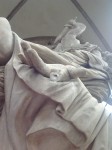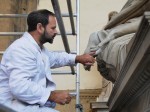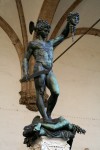 Last Thursday, March 28th, at 11:20 PM, a woman in her 30s identified as a German tourist of Polish origin snapped a finger off The Rape of Polyxena, an 19th century statue by Pio Fedi in the Loggia dei Lanzi adjoining the Uffizi Gallery. The private security guard contracted with watching the Loggia at night alerted the police immediately after the incident, giving them a precise description of the alleged culprit. The police were then able to stop the woman as she attempted to leave the area. She has been charged with damaging the statue.
Last Thursday, March 28th, at 11:20 PM, a woman in her 30s identified as a German tourist of Polish origin snapped a finger off The Rape of Polyxena, an 19th century statue by Pio Fedi in the Loggia dei Lanzi adjoining the Uffizi Gallery. The private security guard contracted with watching the Loggia at night alerted the police immediately after the incident, giving them a precise description of the alleged culprit. The police were then able to stop the woman as she attempted to leave the area. She has been charged with damaging the statue.
 Rape in this sense means kidnapping, like the rape of the Sabine women, a classical subject that is depicted in another of the statues in the Loggia. The statue depicts Achilles taking Trojan princess Polyxena who has offered herself in exchange for the return of her brother Hector’s body. Achilles grasps her securely in his left arm while he raises the sword with his right arm to beat back Queen Hecuba, Polyxena’s mother, who clings desperately to her daughter. On his back under Achille’s feet is the dead Prince Hector. It’s the index finger of Hector’s left hand that was snapped off.
Rape in this sense means kidnapping, like the rape of the Sabine women, a classical subject that is depicted in another of the statues in the Loggia. The statue depicts Achilles taking Trojan princess Polyxena who has offered herself in exchange for the return of her brother Hector’s body. Achilles grasps her securely in his left arm while he raises the sword with his right arm to beat back Queen Hecuba, Polyxena’s mother, who clings desperately to her daughter. On his back under Achille’s feet is the dead Prince Hector. It’s the index finger of Hector’s left hand that was snapped off.
This is sadly not the first time Hector’s fingers have been subjected to vandalism. They are all plaster now because all of them have had to be replaced at one time or another. This is the third time in just four years that somebody has damaged Hector’s fingers. The most recent incident before this latest one happened last October, again the victim was the index finger of the left hand. That may have been an accident rather than a deliberate act of vandalism, though. Security cameras only show one person getting anywhere near the statue between the last time the finger was seen in place and the time it was found missing: the expert who was dusting it.
 When the finger was replaced in October, they wisely planned ahead, inserting a small wooden dowel between the finger and the hand that would make reattaching easier and that would help avoid additional damage to the marble. Alberto Casciani, the same restorer who inserted the dowel and attached a plaster replacement finger in October, was enlisted on Friday morning to reattach the finger again, so poor Hector was only missing his index finger for a few hours this time around.
When the finger was replaced in October, they wisely planned ahead, inserting a small wooden dowel between the finger and the hand that would make reattaching easier and that would help avoid additional damage to the marble. Alberto Casciani, the same restorer who inserted the dowel and attached a plaster replacement finger in October, was enlisted on Friday morning to reattach the finger again, so poor Hector was only missing his index finger for a few hours this time around.
The Rape of Polyxena was sculpted between 1855 and 1865. Pio Fedi researched it assiduously — many of his sketches and plans for the piece are in museums in Florence and Rome — and it’s widely considered the greatest of all his works. Its held as a highly significant example of 19th century Italian art and has the honor of being the only modern(ish) sculpture in the Loggia dei Lanzi. All of the other sculptures are ancient — like Menelaus Supporting the Body of Patroclus, a late 1st century A.D. Roman copy of a Greek original from the 3rd century B.C. — or Renaissance — like the bronze Perseus with the head of Medusa (1554) by Benvenuto Cellini, his masterpiece and the most famous and beloved of the statues in the Loggia.
 The Loggia dei Lanzi is an arched open area in the Piazza della Signoria that was originally built in the 14th century to hold public ceremonies. It got its name in the 16th century when Duke Cosimo I de’ Medici briefly stationed his German mercenary Landsknecht troops — pikemen and infantrymen reputed to be the best fighters money could buy — in the Loggia. Landsknecht was Italianized to Lanzichenecchi which was shortened to Lanzi. It was already a public sculpture gallery by then. Cellini’s Perseus was specifically commissioned by Cosimo I for placement in the Loggia.
The Loggia dei Lanzi is an arched open area in the Piazza della Signoria that was originally built in the 14th century to hold public ceremonies. It got its name in the 16th century when Duke Cosimo I de’ Medici briefly stationed his German mercenary Landsknecht troops — pikemen and infantrymen reputed to be the best fighters money could buy — in the Loggia. Landsknecht was Italianized to Lanzichenecchi which was shortened to Lanzi. It was already a public sculpture gallery by then. Cellini’s Perseus was specifically commissioned by Cosimo I for placement in the Loggia.
It may not retain its public openness for long if this kind of vandalism continues. For now the Uffizi has simply increased security, but there are rumblings of more draconian approaches to come.
“We need to section off the Loggia dei Lanzi and allow only controlled access, not free access, as has been the case up to now. Perhaps it is even the case to close it off at night,” Uffizi Director Antonio Natali said.
“It’s not the first time something like this has happened, and we need to find a protection system so that these events are not repeated.”
